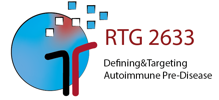MD B7: Testing the effect of kinase inhibitors in the human skin organ culture model for pemphigus foliaceus
Pemphigus foliaceus (PF) is an autoimmune blistering skin disease related to the more common pemphigus vulgaris (PV). In PV, autoantibodies target desmosomal adhesion molecules desmoglein (dsg) 1 and 3, leading to intraepithelial split formation. This process, known as acantholysis, clinically manifests as vesicles and erosions in the skin and mucous membranes resulting in scaling and bleeding. PF is distinguished by autoantibodies that exclusively target dsg1, affecting only the outer skin, not the mucous membranes. Lesions typically appear in seborrheic areas such as the upper trunk, face and scalp, where subcorneal blister formation leads to puff pastry-like lesions.
Current treatments for PF include high-dose systemic corticosteroids, immunoapheresis of circulating autoantibodies and intravenous immunoglobulins, including the anti-CD20 antibody Rituximab. However, no targeted treatments have been established yet. This project aims to determine whether PF shares a similar pathomechanism with PV and to clarify the role of kinases in this process. The human skin organ culture (HSOC) model for PF replicates intraepidermal split formation by introducing a specific single-chain variable fragment (scFv). My goal is to evaluate the effectiveness of kinase inhibitors using this HSOC model for PF.

- Projects
- 1st Generation
- A: Defining Autoimmune Pre-Disease
- B: Targeting of Autoimmune Pre-Disease
- Associated projects
- Medical doctoral researcher projects
- Concluded projects
- Doctoral researchers
- Medical doctoral researchers
- MD A1: Investigation of the influence of specific CDK inhibitors on neutrophil activation
- MD A2: Anatomical expression of target antigens in autoimmune blistering dermatoses as markers for lesion formation
- MD A3: Structural characterization of skin-directed autoantibodies and their interaction with the antigen to gain insights into autoimmune pre-disease
- MD A4: Do interactions between AT1R autoantibodies derived from patients with systemic sclerosis and endothelial cells lead to endothelial dysfunction?
- MD A5: Establishing a human 3D skin model for pemphigus vulgaris
- MD A6: Assessing vasculopathy in systemic sclerosis using optical coherence tomography
- MD A7: Identification of autoantibodies contributing to the break of immunotolerance in immunization induced mucous membrane pemphigus mouse model
- MD A8: Impact of angiotensin II type 1 receptor antibodies on endothelial dysfunction in systemic sclerosis
- MD A9: Impact of glycosylation on IgG4-induced signaling in neutrophils
- MD A10: Testing a new single chain variable fragment for pemphigus foliaceus in the human skin organ culture model
- MD A11: Impact of glycosylation on IgG3-induced signaling in neutrophiles
- MD A12: Screening for inhibitors to prevent keratinocyte dissociation
- MD A13: Investigation of the local and systemic complement activation in bullous pemphigoid patients
- MD A14: Impact of different IgG subclasses and glycosylation patterns on immune complex-induced signaling in neutrophils
- MD A15: Novel target antigens of the lower basal membrane zone as inducers of autoimmunity of bullous autoimmune dermatoses
- MD A16: Identification of the major epitope of the BP180 ectodomain recognized by serum IgA autoantibodies of patients with pemphigoid diseases – IgA autoantibodies as prognostic marker?
- MD A17: Autoantibody-mediated effects on endothelial and immune cell signaling in systemic sclerosis
- MD A18: Molecular and cellular characterization of pre-autoimmune effects induced by aging in mice
- MD A19: Immunogenic effects of Staphylococcus aureus toxins in autoimmune vasculitis
- MD B1: Testing the effect of kinase inhibitors in the human skin organ culture model for pemphigus vulgaris
- MD B2: Investigation of cigarette smoking-induced autoantibodies against human airway epithelial cells in patients with chronic obstructive lung disease
- MD B3: Contribution of taurine, pyridoxine and pantothenic acid to the pathomechanism of pemphigus vulgaris
- MD B4: The influence of prednisolone treatment on split formation in the human skin organ culture model for pemphigus vulgaris
- MD B5: Molecular characterization of the pre-autoimmune effects of Western diet in healthy mice
- MD B6: Testing established MAP kinase inhibitors in a different approach of the human skin organ culture model for pemphigus vulgaris
- MD B7: Testing the effect of kinase inhibitors in the human skin organ culture model for pemphigus foliaceus
- Ass. doctoral researchers
- Ass. medical doctoral researchers
- 2nd Generation
- 1st Generation
Medical doctoral researcher

Participating Researchers


Mentor



